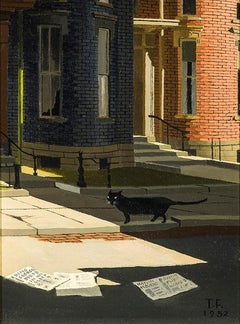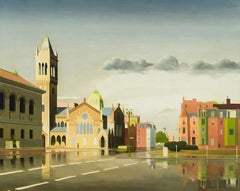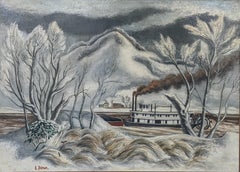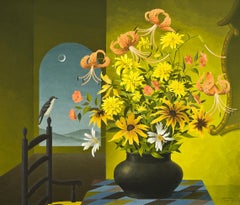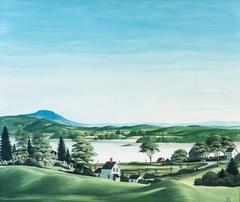Thomas Fransioli Art
to
4
2
2
2
2
Overall Height
to
Overall Width
to
3
2
2
2
2
1
1
1
1
1
1
1
1
1
1
1
1
1
4
4
6,827
3,109
2,517
1,217
4
3
3
3
1
Artist: Thomas Fransioli
Street Scene: "King George Dies"
By Thomas Fransioli
Located in New York, NY
Fransioli was born in Seattle, Washington, and received a degree in architecture from the University of Pennsylvania in 1930. He worked with John Russell Pope on plans for the exhibition galleries at the National Gallery of Art in Washington, D.C., which he pinpointed as the beginning of his interest in painting. World War II interrupted a promising career in architecture. Fransioli served in the Pacific Theatre from 1943 until 1946, and was among the first American soldiers to survey Hiroshima after the atomic bomb’s detonation in August 1945. He returned to civilian life and took up painting, basing himself in Boston, but working up and down the eastern seaboard.
Thomas Fransioli’s cityscapes are crisp and tidy. Buildings stand in bold outline, their forms squarely defined by stark light and long shadows. Saturated color permeates every corner of his canvases, from vibrant oranges and greens to smoky terra cottas and granites. Even the trees that line Fransioli’s streets, parks, and squares are sharp and angular, exactly like those in an architect’s elevation rendering. But Fransioli’s cities often lack one critical feature: people. His streets are largely deserted, save for parked cars and an occasional black cat scurrying across the pavement. People make rare appearances in Fransioli’s compositions, and never does the entropy of a crowd overwhelm their prevailing sense of order and precision. People are implied in a Fransioli painting, but their physical presence would detract from the scene’s bleak and surreal beauty.
Magic Realism neatly characterizes Fransioli’s artistic viewpoint. The term was first broadly applied to contemporary American art in the 1943 Museum of Modern Art exhibition, American Realists and Magic Realists. As exhibition curator Dorothy Miller noted in her foreword to the catalogue, Magic Realism was a “widespread but not yet generally recognized trend in contemporary American art…. It is limited, in the main, to pictures of sharp focus and precise representation, whether the subject has been observed in the outer world—realism, or contrived by the imagination—magic realism.” In his introductory essay, Lincoln Kirstein took the concept a step further: “Magic realists try to convince us that extraordinary things are possible simply by painting them as if they existed.”
This is Fransioli, in a nutshell. His cityscapes exist in time and space, but certainly not in the manner in which he portrays them.
Fransioli—and other Magic Realists of his time—was also the heir to Precisionism, spawned from Cubism and Futurism after the Great War and popularized in the 1920s and early 1930s. While Fransioli may not have aspired to celebrate the Machine Age, heavy industry, and skyscrapers in the same manner as Charles Sheeler, his compositions tap into the same rigid gridwork of the urban landscape that was first codified by the Precisionists.
During the 1950s, Fransioli was represented by the progressive Margaret Brown...
Category
20th Century American Realist Thomas Fransioli Art
Materials
Canvas, Oil
Copley Square, Boston
By Thomas Fransioli
Located in New York, NY
Thomas Fransioli’s cityscapes are crisp and tidy. Buildings stand in bold outline, trees are sharp, and saturated color permeates the scene. But Fransioli’s cities often lack one critical feature: people. His streets are largely deserted, save for the rare appearance of figure and the occasional black cat scurrying across pavement. Instead, humanity is implied. Magic Realism neatly characterizes Fransioli’s viewpoint. First applied to American art in the 1943 MoMA exhibition “American Realists and Magic Realists...
Category
20th Century American Realist Thomas Fransioli Art
Materials
Canvas, Oil
Mt. Etna from Taormina
By Thomas Fransioli
Located in New York, NY
Thomas Fransioli, born in 1906 in Seattle, Washington, trained as an architect at the University of Pennsylvania. He worked as an architect before his service in World War II. Largel...
Category
20th Century American Realist Thomas Fransioli Art
Materials
Canvas, Oil
Edam, Holland
By Thomas Fransioli
Located in New York, NY
Thomas Fransioli’s cityscapes are crisp and tidy. Buildings stand in bold outline, their forms squarely defined by stark light and long shadows. Saturated color permeates every corner of his canvases, from vibrant oranges and greens to smoky terra cottas and granites. Even the trees that line Fransioli’s streets, parks, and squares are sharp and angular, exactly like those in an architect’s elevation rendering. But Fransioli’s cities often lack one critical feature: people. His streets are largely deserted, save for parked cars and an occasional black cat scurrying across the pavement. People make rare appearances in Fransioli’s compositions, and never does the entropy of a crowd overwhelm their prevailing sense of order and precision. People are implied in a Fransioli painting, but their physical presence would detract from the scene’s bleak and surreal beauty.
Magic Realism neatly characterizes Fransioli’s artistic viewpoint. The term was first broadly applied to contemporary American art in the 1943 Museum of Modern Art exhibition, American Realists and Magic Realists. As exhibition curator Dorothy Miller noted in her foreword to the catalogue, Magic Realism was a “widespread but not yet generally recognized trend in contemporary American art…. It is limited, in the main, to pictures of sharp focus and precise representation, whether the subject has been observed in the outer world—realism, or contrived by the imagination—magic realism.” In his introductory essay, Lincoln Kirstein took the concept a step further: “Magic realists try to convince us that extraordinary things are possible simply by painting them as if they existed.”
This is Fransioli, in a nutshell. His cityscapes exist in time and space, but certainly not in the manner in which he portrays them.
Fransioli—and other Magic Realists of his time—was also the heir to Precisionism, spawned from Cubism and Futurism after the Great War and popularized in the 1920s and early 1930s. While Fransioli may not have aspired to celebrate the Machine Age, heavy industry, and skyscrapers in the same manner as Charles Sheeler, his compositions tap into the same rigid gridwork of the urban landscape that was first codified by the Precisionists.
During the 1950s, Fransioli was represented by the progressive Margaret Brown...
Category
20th Century American Realist Thomas Fransioli Art
Materials
Paper, Gouache
Related Items
Texas Hill Country Landscape with Argemone, Coreopsis, and Flowering Cactus"
By Don Warren
Located in Austin, TX
A breathtaking Texas Hill Country landscape painted by American Plain Air painter, Don Warren. The painting is executed in oil on canvas and measures 18 by 24 inches. It is beautifully framed and ready to hang in a gold leaf frame that measures 25 by 31 inches.
The scene depicts a clear, idyllic summer day along trail through pastoral lands. A meadow of yellow coreopsis and white argemones make up the foreground, framing the focal point: prickly pair...
Category
Mid-20th Century American Realist Thomas Fransioli Art
Materials
Canvas, Oil
"Along the Kanahawa River, West Virginia, " Ernest Fiene, WPA Coal Steamboat
By Ernest Fiene
Located in New York, NY
Ernest Fiene
Along the Kanahawa River, West Virginia, 1936
Signed lower right
Oil on canvas
26 x 36 inches
Fiene made a series of paintings, drawings and lithographs which are based on his travels through Pennsylvania and West Virginia during the winter of 1935-36. The industrial areas of Pennsylvania and West Virginia are represented in numerous oils, among which are some of his most well-known. Fiene wrote of the trip, "The increasing snow and atmospheric conditions [in the Kanawha River valley} enhanced this mountainous coal mining country with a majestic beauty."
Winter on the River is Fiene's only American Artists Group print and there were only two lithographs produced from the West Virginia trip. The American Artists Group (AAG), under the direction of Carl Zigrosser, who was then working at New York's famed Weyhe Gallery, published ninety-three prints by over fifty artists in 1936 and 1937. Zigrosser's goal was to popularize contemporary American art through original prints offered at the low price of $2.75. The project was also a means to provide income for impoverished artists during the Depression. The prints were featured in many of the leading print exhibitions and publications of the period. The lithograph produced from this image is now in the collection of the Amon Carter Museum, Baltimore Museum of Art, Cleveland Museum of Art, Philadelphia Museum of Art, Pensacola Museum of Art, San Francisco Fine Arts Museum, Syracuse Museum, Yale University Art Museum.
Ernest Fiene was born in Elberfeld, Germany in 1894. As a teenager, Fiene immigrated to the United States in 1912. He studied art at the National Academy of Design in New York City from 1914 to 1918, taking day classes with Thomas Maynard and evening classes with Leon Kroll. Fiene continued his studies at the Beaux-Arts Institute of Design in New York from 1916 to 1918, adding classes in printmaking at the Art Students League in 1923.
Fiene began his career as an artist in 1919 with his first exhibition of watercolors at the MacDowell Club arranged by his mentor Robert Henri. In 1923 the Whitney Studio Club mounted a large exhibition of his works. The following year he had an exhibition at the New Gallery in New York, which completely sold out all fifty-two works, including paintings, watercolors, drawings, and etchings. With the proceeds of sales from the New Gallery exhibition, Ernest Fiene and his younger brother Paul, a sculptor, built studios in Woodstock, New York in 1925.
In the early Twenties Ernest Fiene painted mostly landscapes of Woodstock and both the Ramapo and Hudson River Valleys. The first monograph from the Younger Artists Series was published on Fiene in 1922. Published in Woodstock, the series went on to include Alexander Brook, Peggy Bacon, and Yasuo Kuniyoshi. The book reproduced 1 illustration in color and another 27 reproductions in black and white. Around 1925 Fiene became fascinated with the intensity, excitement, and opportunities for color harmonies New York City offered as a subject. His paintings shifted to urban and industrial themes with architecture, industry, and transportation becoming his subjects.
By 1926 Fiene had attracted the dealer Frank K.M. Rehn, who gave him a one-man exhibition that year, which travelled to the Boston Arts Club. C.W. Kraushaar Galleries gave Fiene a one-man exhibition of urban, landscape, portrait, and still life paintings in 1927. Julianna Force, the director of the Whitney Studio Club and first director of the Whitney Museum of American Art, included two of Fiene’s paintings in a fall exhibition in 1928. The Whitney Studio Club showed Fiene’s paintings in a two-man exhibition with Glenn O. Coleman that year and acquired three of Fiene’s paintings. Also in 1928 Fiene became affiliated with Edith Halpert’s Downtown Gallery where he had an exhibition of 20 lithographs in the spring. Fiene sold his house in Woodstock in 1928 to spend more of his time in New York City.
With so many successful exhibitions, Fiene returned to Paris in 1928-29 where he rented Jules Pascin's studio and studied at the Académie de la Grande Chaumière. In France, Fiene painted both landscape and urban subjects developed from ideas influenced by Cubist geometry and the use of flat areas of broad color. Upon returning to New York in 1930, Fiene used this new approach to continue to paint New York skyscraper and waterfront subjects, as well as to begin a series of paintings on changing old New York based on the excavations for Radio City Music Hall and the construction of the Empire State Building. Frank K.M. Rehn Galleries exhibited this series, titled “Changing Old New York,” in 1931. Fiene also has solo exhibitions at Rehn Galleries in 1930 and 1932. Fiene’s oil paintings are exhibited at the Chicago Arts Club in 1930 as well.
Fiene was included in the Museum of Modern Art’s exhibition Painting and Sculpture by Living Americans in December of 1931. Visiting New York, Henri Matisse saw the exhibition and called Fiene’s Razing Buildings, West 49th Street the finest painting he had seen in New York. Fiene had two mural studies from his Mechanical Progress series exhibited at the Museum of Modern Art’s exhibition Murals by American Painters and Photographers in 1932. Fiene sent View from my Window which depicts Fiene working on a lithograph stone while looking out his window to the newly completed Empire State Building to the Carnegie International in 1931. In 1932 Fiene participated in the first Biennial of American Painting at the Whitney Museum and his prints were included in exhibitions at the Downtown Gallery and the Wehye Gallery. In the same year, Fiene was awarded a Guggenheim fellowship to further study mural painting in Florence, Italy.
On his return from Italy in 1933 Fiene re-engaged himself in New York City life and won several public and private mural projects. Fiene resumed his active exhibition schedule, participating in two group exhibitions at the Whitney Museum and a one-man exhibition of recent paintings at the Downtown Gallery in January 1934. In 1933 he purchased a farm in Southbury, Connecticut, which added Connecticut scenes to his landscape subjects. This was also the year Fiene began to spend summers on Monhegan Island, Maine, where he painted seascapes, harbor scenes, and still lifes.
Fiene’s landscape paintings attracted numerous commissions as part of the American Scene movement. Through the fall and winter of 1935-36, Fiene took an extended sketching trip through the urban, industrial, and farming areas of Pennsylvania and West Virginia. Most of the twenty-four Pennsylvania urban and rural paintings from this trip were featured in an exhibition held at the First National Bank in Pittsburgh in October of 1937 by the Pittsburgh Commission for Industrial Expansion. Fiene said of these works that he formed rhythm, opportunity for space and color, and integrity in the Pennsylvania mill and furnace paintings. Fiene received the silver medal for one of the Pittsburgh paintings...
Category
1930s American Realist Thomas Fransioli Art
Materials
Canvas, Oil
Grey Ocean
By Willard Dixon
Located in Burlingame, CA
Unique contemporary 'Grey Ocean' depicts a provocative grey sky with a blue, yellow and white sea. Choppy waters beneath a sky alive with filtered early evening light and unknown imp...
Category
21st Century and Contemporary American Realist Thomas Fransioli Art
Materials
Canvas, Oil
Gourds
By Mark Schiff
Located in Boca Raton, FL
Gourds by Mark Schiff
We guarantee that you will love this painting. If not, you can return it for a complete refund, no questions asked.
Category
Early 2000s American Realist Thomas Fransioli Art
Materials
Oil, Canvas
Antique Oil Painting William Weaver Armstrong Mount Hood Oregon Landscape 1885
Located in Portland, OR
A large oil on Canvas painting by the California artist William Weaver Armstrong (1862-1906), Mount Hood Oregon landscape, circa 1885.
This large lan...
Category
1880s American Realist Thomas Fransioli Art
Materials
Canvas, Oil
"Cardinal Rule" Two birds sitting among colorful flowers
By Edwina Lucas
Located in Sag Harbor, NY
Two Cardinal birds sit on colorful flowers in this American Realist painting. An abstracted blue background allows the viewer to focus on the still life. Lucas is masterful at distil...
Category
2010s American Realist Thomas Fransioli Art
Materials
Canvas, Oil
Mendocino Coast
By Willard Dixon
Located in Burlingame, CA
'Mendocino Coast' original oil painting by American realist artist Willard Dixon, features a vivid and expanding California sunset ocean view. Willard Dixon has painted coastal lands...
Category
21st Century and Contemporary American Realist Thomas Fransioli Art
Materials
Canvas, Oil
Santa Monica Beach, 11AM
By Wes Hempel
Located in Fairfield, CT
Represented by George Billis Gallery, NYC & LA --A walk through any major museum will reveal paintings that depict or legitimate only certain kinds of experience. Despite the good in...
Category
2010s American Realist Thomas Fransioli Art
Materials
Canvas, Oil
diablo View
By Willard Dixon
Located in Burlingame, CA
‘Diablo View’ an original oil painting by American realist artist Willard Dixon, featuring distant rolling hills and expansive hazy blue sky. Willard Dixon has painted landscapes and...
Category
21st Century and Contemporary American Realist Thomas Fransioli Art
Materials
Canvas, Oil
The Road, Landscape Oil painting, Realism style, Texas artist, Texas Hill Country
By Garrett Middaugh
Located in Houston, TX
The Road depicts the Texas Hill Country which is Garrett Middaugh's favorite painting locations. This is painted in the style of Realism. This is a 2...
Category
2010s American Realist Thomas Fransioli Art
Materials
Cotton Canvas, Oil
Man Working Mid 20th Century American Scene Social Realism Industrial WPA Modern
By Jo Cain
Located in New York, NY
Man Working Mid 20th Century American Scene Social Realism Industrial WPA Modern
Jo Cain (1904 - 2003)
Telephone Pole Worker
38 1/4 x 18 1/2 inches
Oil on pap...
Category
1930s American Realist Thomas Fransioli Art
Materials
Paper, Gouache
"Herd of Elephants", David Shepherd, 20x35.5, Original Oil, Realistic Wildlife
By David Shepherd
Located in Dallas, TX
This orginal oil painting entitled "Herd of Elephants" measures 20x35.5 unframed. It is finished with a white-washed rustic frame with a silver inlay. An elephant herd travels through the African...
Category
1980s American Realist Thomas Fransioli Art
Materials
Canvas, Oil
Previously Available Items
Still Life of Flowers
By Thomas Fransioli
Located in New York, NY
Signed and dated (at lower right): FRANSIOLI 1959
Category
Mid-19th Century American Realist Thomas Fransioli Art
Materials
Canvas, Oil
View from The Hill, Castine
By Thomas Fransioli
Located in New York, NY
Signed and dated (at lower right): T.F./1946
Category
1940s American Realist Thomas Fransioli Art
Materials
Canvas, Oil
Street Scene in Bar-le-Duc
By Thomas Fransioli
Located in New York, NY
Signed and dated (at lower right): TF/1952
Category
1950s American Realist Thomas Fransioli Art
Materials
Canvas, Oil
Thomas Fransioli art for sale on 1stDibs.
Find a wide variety of authentic Thomas Fransioli art available for sale on 1stDibs. You can also browse by medium to find art by Thomas Fransioli in paint, canvas, fabric and more. Not every interior allows for large Thomas Fransioli art, so small editions measuring 7 inches across are available. Customers who are interested in this artist might also find the work of Max Ferguson, William Rickarby Miller, and Cecil Crosley Bell. Thomas Fransioli art prices can differ depending upon medium, time period and other attributes. On 1stDibs, the price for these items starts at $14,000 and tops out at $55,000, while the average work can sell for $31,500.
